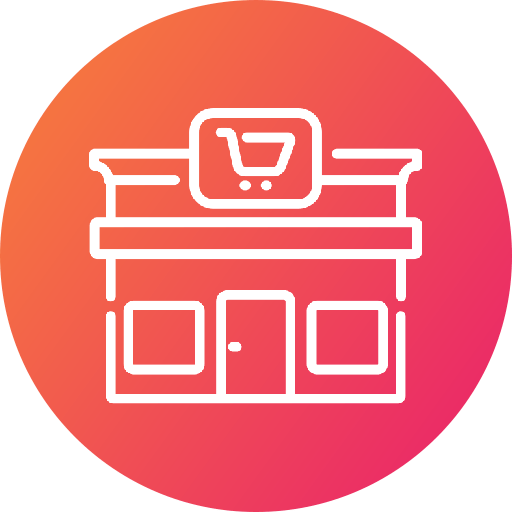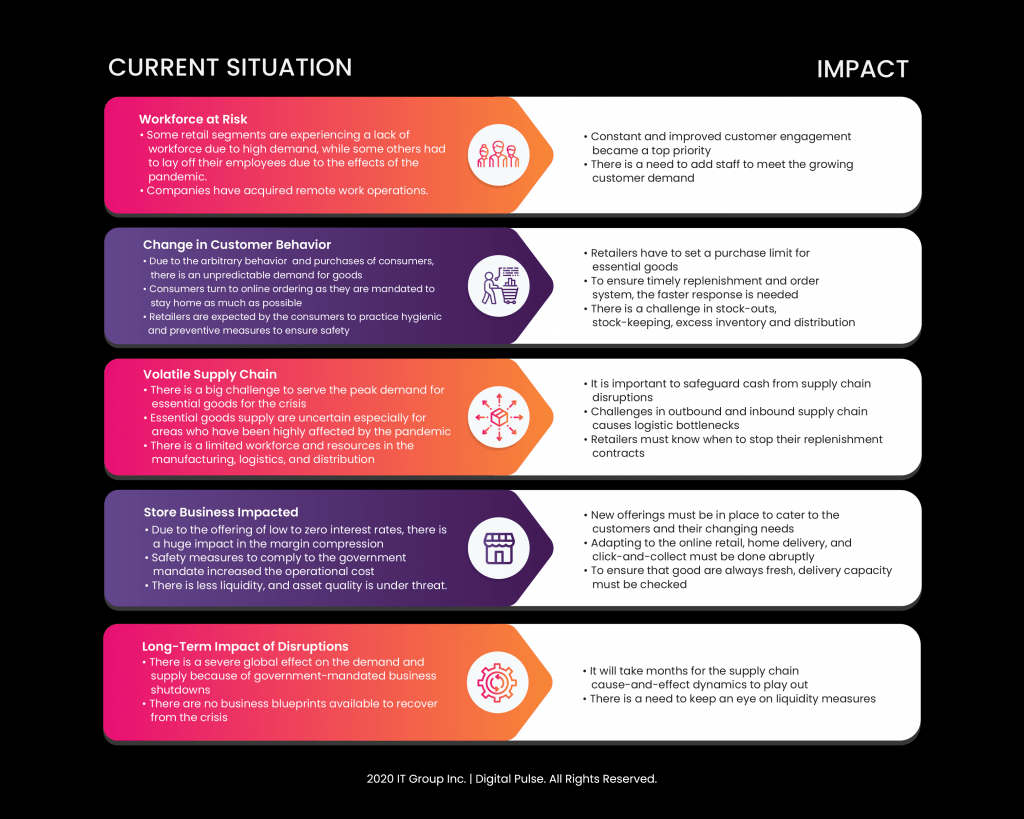
Creating an Agile Business for a Customer-centric Retail World
Downloadable Resources
Navigating Retail to Emerge Stronger Digitally

Industry Impact of COVID-19
COVID-19 has created a huge impact on a global scale that led to an unprecedented worldwide economic disruption.
There is a severe hit in the retailer industry during the crisis. Significantly high demand for certain products took off due to the panic-buying behavior of consumers. While demand skyrocketed for some products, some products went down low, which piled up as unsellable inventory. A big responsibility lands into the laps of essential goods retailers to continually provide goods in every way possible. This leads retailers to adapt to innovation at a faster rate in order to mitigate the fluctuation of both supply and demand as they shift towards online business operations
The most challenging move for retailers is to abruptly adjust their plans for the end of the year in order for their business to continually operate. At this point where everything is still uncertain, no one has a blueprint of what is effective or what is not in this kind of situation. Any forecasts of retailing models done might only be accurate for a few months and then shift to another until there is a balance between demand and supply again. Business owners are finding ways to make sure that despite the uncertainty, there is a way to stabilize their operations and have profitable growth.


ITG to Help Enable
- Companies are continually updating their response due to COVID-19 situations to ensure that employee and customer safety is a top priority.
- Retailers are forced to hire a contingent workforce to ensure business continuity and productivity during the crisis
- As operations are shifted to a work from home environment, there is a significant challenge to maintain business continuity
- Due to the government-mandated business shutdowns, business owners are forced to find alternative ways of selling and reaching out to their consumers.
- Customers are always on the lookout for up-to-date information on opening hours, restrictions, product availability, and crisis-related offerings and services.
- Retailers are looking for more ways to ensure that their customers remain to be loyal in the continuous supply of critical products
- Due to the government-mandated road shutdowns, there is a disruption in the supply chain because of restrictions and transportation delays
- There is an uncertain change in demand movement wherein there is both a significant drop and increase occurring
- Struggle in sales information visibility
- Switching to an alternative supplier to fill the demand can mean an increase in costs due to hoc volume planning, new delivery routing, and additional transportation resources, manufacturing.
- There is an expected decrease in revenue for most retailers as people reduce to a minimum of consumption due to restrictions
- Supply cost can either rise or remain as some supplier negotiations might not be fulfilled
- Goods that are past the expiration date cannot be sold anymore, while other retailers in the luxury, fashion, and similar segments might not be able to sell
- Supplier and creditor payments might be suspended to prevent a total financial crash
- In-store retailers are taking the challenge in reinventing the way they serve customers since face-to-face contact is challenging which results in contactless transactions
- Workforce capacity of grocery and drug stores is challenged due to the increase if contactless transactions such as online ordering as they are the key fulfillment locations
- Communication to the customers must be consistent and reliable to ensure the information such as product offerings, store hours, and additional services., Servicing shifts are well disseminated
- Customers and business owners will continually be concerned about close contact that can lead to infection
- Companies are continually updating their response due to COVID-19 situations to ensure that employee and customer safety is a top priority.
- Retailers are forced to hire a contingent workforce to ensure business continuity and productivity during the crisis
- As operations are shifted to a work from home environment, there is a significant challenge to maintain business continuity
- Due to the government-mandated business shutdowns, business owners are forced to find alternative ways of selling and reaching out to their consumers.
- Customers are always on the lookout for up-to-date information on opening hours, restrictions, product availability, and crisis-related offerings and services.
- Retailers are looking for more ways to ensure that their customers remain to be loyal in the continuous supply of critical products
- Due to the government-mandated road shutdowns, there is a disruption in the supply chain because of restrictions and transportation delays
- There is an uncertain change in demand movement wherein there is both a significant drop and increase occurring
- Struggle in sales information visibility
- Switching to an alternative supplier to fill the demand can mean an increase in costs due to hoc volume planning, new delivery routing, and additional transportation resources, manufacturing.
- There is an expected decrease in revenue for most retailers as people reduce to a minimum of consumption due to restrictions
- Supply cost can either rise or remain as some supplier negotiations might not be fulfilled
- Goods that are past the expiration date cannot be sold anymore, while other retailers in the luxury, fashion, and similar segments might not be able to sell
- Supplier and creditor payments might be suspended to prevent a total financial crash
- In-store retailers are taking the challenge in reinventing the way they serve customers since face-to-face contact is challenging which results in contactless transactions
- Workforce capacity of grocery and drug stores is challenged due to the increase if contactless transactions such as online ordering as they are the key fulfillment locations
- Communication to the customers must be consistent and reliable to ensure the information such as product offerings, store hours, and additional services., Servicing shifts are well disseminated
- Customers and business owners will continually be concerned about close contact that can lead to infection

